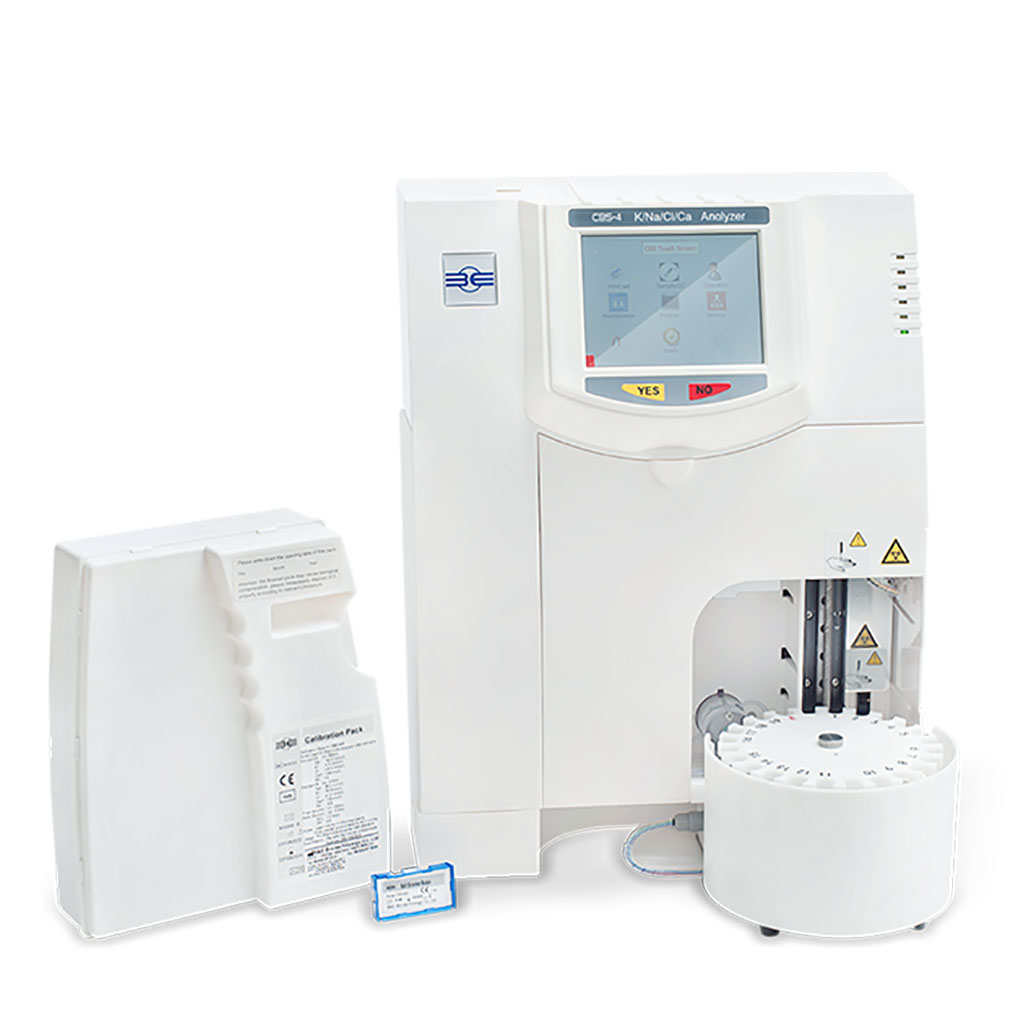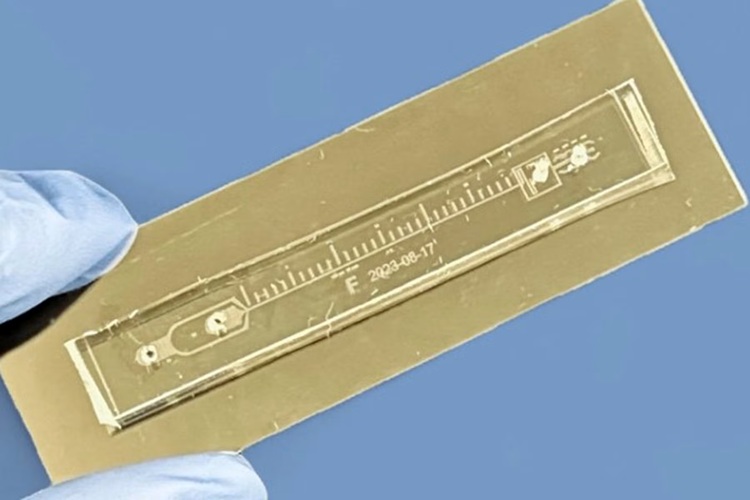Next-Gen Electrolyte Analyzers with Bio-Sensor Cartridge Technology Simplify Clinical Analysis
|
By LabMedica International staff writers Posted on 10 Jul 2023 |

Electrolytes and metabolites offer valuable insights into the body's metabolic processes. Electrolyte analyzers measure ion concentrations in the blood, such as potassium, sodium, bicarbonate, chloride, calcium, glucose, lactate, and magnesium. This analysis helps identify medical conditions like kidney failure, heart failure, uncontrolled diabetes, hemorrhage, chemical poisoning, drug overdose, shock, asthma, and chronic obstructive pulmonary disease (COPD). One of the significant long-term advancements in the electrolyte analyzer market is the creation of technologically enhanced devices and the utilization of sophisticated sensors for monitoring critical parameters like pH level and electrolyte concentration. Now, next-generation electrolyte analyzers with advanced features enable increased accuracy and productivity while shortening the turnaround time for each sample, and reducing human input errors.
The CBS series, a direct ISE analyzer, from B&E Biotechnology Co. Ltd. (Yantai, China) measures whole blood or serum samples directly without the need for dilution. The CBS series (e.g., the CBS-5) measures pH, K, Na, Cl, iCa, and TCO2, and offer simple module replacement. These analyzers come with a 20-hole sample tray and can test 60 samples per hour. The CBS series is popular in numerous countries worldwide, with approximately 10,000 units currently installed. Additionally, the company also offers the KS series of indirect ISE analyzers (e.g., the KS 401) which can automatically dilute samples up to 20 times for testing and can process up to 120 samples per hour. They offer easy electrode module replacement and have a long module lifespan (10,000 samples or two months of operation). With capabilities such as switching between serum mode and urine mode with a single click, direct total calcium testing, and a 60-hole sample tray, the KS series is particularly suitable for medium-sized hospitals. Due to its small sample size, flexibility, and ease of use, the KS series is also making waves in the global market.
Both the CBS and KS series of analyzers utilize multi-sensor modules developed from B&E's extensive technical experience in multi-biosensor technology (MBT). The modules, comprising ceramic plates and specific ion-selective membrane ingredients, exhibit impressive linearity, reproducibility, and long-term stability. Leveraging its MBT applications, B&E has also developed an electrolyte biosensor unit (EBU) that can be adapted to automatic biochemistry analyzers for electrolyte analysis to dramatically reduce running costs.
Related Links:
B&E Biotechnology Co. Ltd.
Latest Clinical Chem. News
- Chemical Imaging Probe Could Track and Treat Prostate Cancer
- Mismatch Between Two Common Kidney Function Tests Indicates Serious Health Problems
- VOCs Show Promise for Early Multi-Cancer Detection
- Portable Raman Spectroscopy Offers Cost-Effective Kidney Disease Diagnosis at POC
- Gold Nanoparticles to Improve Accuracy of Ovarian Cancer Diagnosis
- Simultaneous Cell Isolation Technology Improves Cancer Diagnostic Accuracy
- Simple Non-Invasive Hair-Based Test Could Speed ALS Diagnosis
- Paper Strip Saliva Test Detects Elevated Uric Acid Levels Without Blood Draws
- Prostate Cancer Markers Based on Chemical Make-Up of Calcifications to Speed Up Detection
- Breath Test Could Help Detect Blood Cancers
- ML-Powered Gas Sensors to Detect Pathogens and AMR at POC
- Saliva-Based Cancer Detection Technology Eliminates Need for Complex Sample Preparation
- Skin Swabs Could Detect Parkinson’s Years Before Symptoms Appear
- New Clinical Chemistry Analyzer Designed to Meet Growing Demands of Modern Labs

- New Reference Measurement Procedure Standardizes Nucleic Acid Amplification Test Results
- Pen-Like Tool Quickly and Non-Invasively Detects Opioids from Skin
Channels
Molecular Diagnostics
view channel
Urine Test Detects Inherited Neuropathy Missed by Genetic Screening
Sorbitol dehydrogenase (SORD)-related neuropathy is one of the most common inherited nerve disorders, yet diagnosis often lags because current genetic screens frequently miss the causal gene.... Read more
Genomic Test Predicts Risk of SCC Metastasis
Managing squamous cell carcinoma (SCC) of the skin in patients with one or more risk factors is a significant clinical challenge, especially as SCC-related deaths are now estimated to exceed those from melanoma.... Read moreHematology
view channel
Platelet Activity Blood Test in Middle Age Could Identify Early Alzheimer’s Risk
Early detection of Alzheimer’s disease remains one of the biggest unmet needs in neurology, particularly because the biological changes underlying the disorder begin decades before memory symptoms appear.... Read more
Microvesicles Measurement Could Detect Vascular Injury in Sickle Cell Disease Patients
Assessing disease severity in sickle cell disease (SCD) remains challenging, especially when trying to predict hemolysis, vascular injury, and risk of complications such as vaso-occlusive crises.... Read more
ADLM’s New Coagulation Testing Guidance to Improve Care for Patients on Blood Thinners
Direct oral anticoagulants (DOACs) are one of the most common types of blood thinners. Patients take them to prevent a host of complications that could arise from blood clotting, including stroke, deep... Read moreImmunology
view channel
Chip Captures Cancer Cells from Blood to Help Select Right Breast Cancer Treatment
Ductal carcinoma in situ (DCIS) accounts for about a quarter of all breast cancer cases and generally carries a good prognosis. This non-invasive form of the disease may or may not become life-threatening.... Read more
Blood-Based Liquid Biopsy Model Analyzes Immunotherapy Effectiveness
Immunotherapy has revolutionized cancer care by harnessing the immune system to fight tumors, yet predicting who will benefit remains a major challenge. Many patients undergo costly and taxing treatment... Read moreMicrobiology
view channel
Blood-Based Molecular Signatures to Enable Rapid EPTB Diagnosis
Extrapulmonary tuberculosis (EPTB) remains difficult to diagnose and treat because it spreads beyond the lungs and lacks easily accessible biomarkers. Despite TB infecting 10 million people yearly, the... Read more
15-Minute Blood Test Diagnoses Life-Threatening Infections in Children
Distinguishing minor childhood illnesses from potentially life-threatening infections such as sepsis or meningitis remains a major challenge in emergency care. Traditional tests can take hours, leaving... Read more
High-Throughput Enteric Panels Detect Multiple GI Bacterial Infections from Single Stool Swab Sample
Gastrointestinal (GI) infections are among the most common causes of illness worldwide, leading to over 1.7 million deaths annually and placing a heavy burden on healthcare systems. Conventional diagnostic... Read morePathology
view channel
Blood Test and Sputum Analysis Predict Acute COPD Exacerbation
Chronic obstructive pulmonary disease (COPD) remains a major contributor to global illness, largely driven by cigarette smoking and marked by irreversible lung damage. Acute exacerbations can accelerate... Read more
AI Tool to Transform Skin Cancer Detection with Near-Perfect Accuracy
Melanoma continues to be one of the most difficult skin cancers to diagnose because it often resembles harmless moles or benign lesions. Traditional AI tools depend heavily on dermoscopic images alone,... Read more
Unique Immune Signatures Distinguish Rare Autoimmune Condition from Multiple Sclerosis
Myelin oligodendrocyte glycoprotein antibody–associated disease (MOGAD) is a rare autoimmune disorder in which the immune system attacks the myelin sheath in the central nervous system. Although symptoms... Read moreTechnology
view channel
AI Saliva Sensor Enables Early Detection of Head and Neck Cancer
Early detection of head and neck cancer remains difficult because the disease produces few or no symptoms in its earliest stages, and lesions often lie deep within the head or neck, where biopsy or endoscopy... Read more
AI-Powered Biosensor Technology to Enable Breath Test for Lung Cancer Detection
Detecting lung cancer early remains one of the biggest challenges in oncology, largely because current tools are invasive, expensive, or unable to identify the disease in its earliest phases.... Read moreIndustry
view channel
Abbott Acquires Cancer-Screening Company Exact Sciences
Abbott (Abbott Park, IL, USA) has entered into a definitive agreement to acquire Exact Sciences (Madison, WI, USA), enabling it to enter and lead in fast-growing cancer diagnostics segments.... Read more









 (3) (1).png)













